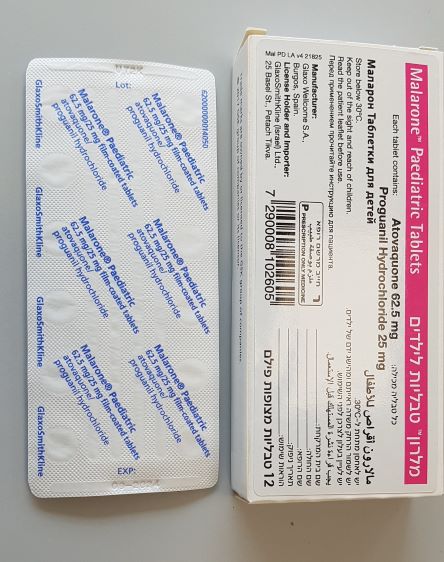Quest for the right Drug

מלרון טבליות לילדים MALARONE PAEDIATRIC TABLETS (ATOVAQUONE, PROGUANIL HYDROCHLORIDE)
תרופה במרשם
תרופה בסל
נרקוטיקה
ציטוטוקסיקה
צורת מתן:
פומי : PER OS
צורת מינון:
טבליות מצופות פילם : FILM COATED TABLETS
עלון לרופא
מינוניםPosology התוויות
Indications תופעות לוואי
Adverse reactions התוויות נגד
Contraindications אינטראקציות
Interactions מינון יתר
Overdose הריון/הנקה
Pregnancy & Lactation אוכלוסיות מיוחדות
Special populations תכונות פרמקולוגיות
Pharmacological properties מידע רוקחי
Pharmaceutical particulars אזהרת שימוש
Special Warning עלון לרופא
Physicians Leaflet
Adverse reactions : תופעות לוואי
4.8 Undesirable effects Malarone Paediatric Tablets In clinical trials of Malarone paediatric tablets for prophylaxis of malaria, 357 children or adolescents 11 to ≤40 kg body weight received Malarone paediatric tablets. Most of these were residents of endemic areas and took Malarone paediatric tablets for about 12 weeks. The rest were travelling to endemic areas, and most took Malarone paediatric tablets for 2-4 weeks. Open label clinical studies investigating the treatment of children weighing between ≥5 kg and <11 kg have indicated that the safety profile is similar to that in children weighing between 11 kg and 40 kg, and adults. There are limited long term safety data in children. In particular, the long-term effects of Malarone on growth, puberty and general development have not been studied. Malarone Tablets for Adults In clinical trials of Malarone in the treatment of malaria the most commonly reported adverse reactions were abdominal pain, headache, anorexia, nausea, vomiting, diarrhoea and coughing. In clinical trials of Malarone for prophylaxis of malaria, the most commonly reported adverse reactions were headache, abdominal pain and diarrhoea. Malarone Tablets for Adults and Malarone Paediatric Tablets The following table provides a summary of adverse reactions that have been reported to have a suspected (at least possible) causal relationship to treatment with atovaquone-proguanil in clinical trials and spontaneous post-marketing reports. The following convention is used for the classification of frequency: very common (≥1/10); common (≥1/100 to <1/10); uncommon (≥1/1,000 to <1/100); rare (≥1/10,000 to <1/1,000); not known (cannot be estimated from the available data). There are limited long term safety data in children. In particular, the long-term effects of Malarone on growth, puberty and general development have not been studied. System Organ Very Common Uncommon Rare Not known2 Class Common Blood and Anaemia Pancytopenia lymphatic Neutropenia 1 disorders Immune Allergic Angioedema3 system reactions Anaphylaxis disorders (see section 4.4) Vasculitis3 Metabolism Hyponatraemia1 Elevated and nutrition Anorexia amylase disorders levels1 Psychiatric Abnormal Anxiety Hallucinations Panic attack disorders dreams Crying Depression Nightmares Psychotic disorder Nervous Headache Insomnia Seizure system Dizziness disorders Cardiac Palpitations Tachycardia disorders Gastrointestina Nausea1 Stomatitis Gastric l disorders Vomiting intolerance3 Diarrhoea Oral ulceration3 Abdomina l pain Hepatobiliary Elevated liver Hepatitis disorders enzymes1 Cholestasis3 Skin and Pruritus Hair loss Stevens-Johnson subcutaneous Urticaria Syndrome tissue Rash Erythema disorders multiforme Blister Skin exfoliation Photosensitivity reactions General Fever disorders and administration site conditions Respiratory, Cough thoracic and mediastinal disorders 1. Frequency taken from atovaquone label. Patients participating in clinical trials with atovaquone have received higher doses and have often had complications of advance Human Immunodeficiency Virus (HIV) disease. These events may have been seen at a lower frequency or not at all in clinical trials with atovaquone-proguanil. 2. Observed from post-marketing spontaneous reports and the frequency is therefore unknown 3. Observed with proguanil. Reporting of suspected adverse reactions Reporting suspected adverse reactions after authorisation of the medicinal product is important. It allows continued monitoring of the benefit/risk balance of the medicinal product. Any suspected adverse events should be reported to the Ministry of Health according to the National Regulation by using an online form https://sideeffects.health.gov.il/ Additionally, you should also report to GSK Israel (il.safety@gsk.com).

שימוש לפי פנקס קופ''ח כללית 1994
לא צוין
תאריך הכללה מקורי בסל
לא צוין
הגבלות
לא צוין
מידע נוסף
